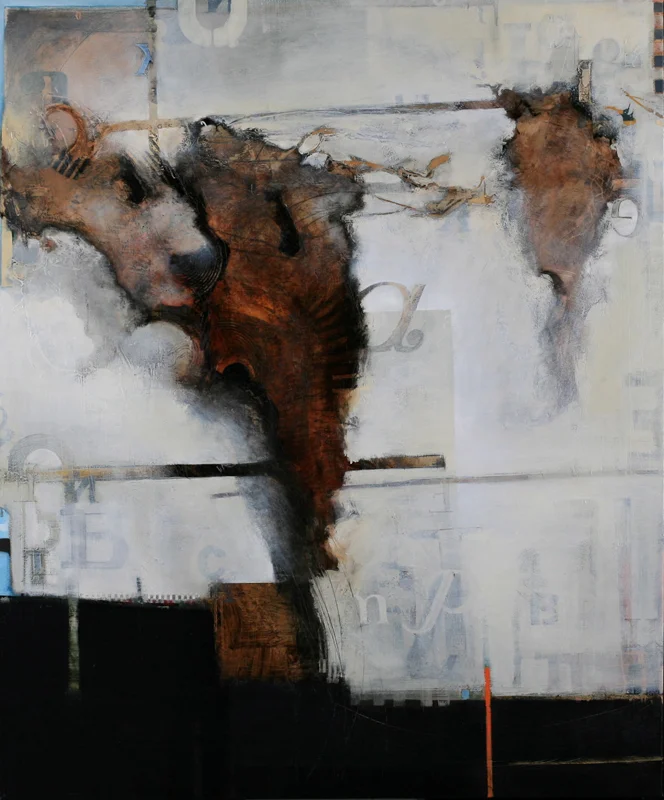
Babak Emanuel. “Resonance,” (2015). Acrylic, oil, paraffin on canvas. 70 x 76 inches.

[](#)[](#)
Being Summoned out of the Dust
Babak Emanuel exhibits at Art Brief: Iranian Contemporary Los Angeles by Advocartsy
For 30 years, Babak Emanuel has studied and practiced his art. From photography to installations to paintings to printmaking, he has worked tirelessly testing the limits of all of these mediums, utilizing each in its way to explore themes equally as varied. Through the lens of his own experiences (and what other lens can we accurately refer to?), and through all the noise of being, he filters his views on existence--the progression, the state of being, and the issues we face in existing. On the subject, he states, “I’m influenced by writers, leaders, or even personalities I come across within life, not to mention the social issues. I report back on what I have learned, observed, or survived and propose new lines of thinking.”
In his long exhibition career, the most recent--Art Brief: Iranian Contemporary Los Angeles, put on by Advocartsy--is his first joint-exhibition with an Iranian art platform. “My work is not related to the Persian arts or Middle Eastern art,” Babak says, although it’s impossible to deny that his experiences as a person and artist, including his being of Iranian origin, inform his work in one way or another. “Art is totally limitless and without boundary. Obviously the pursuit of making art full time is not a small feat--it takes an extraordinary amount of time, dedication, resources--so obviously each artist’s experiences definitely influence the work.” Even so, Babak continually looks to outside sources for inspiration--literature, philosophy, and maybe even a bad film or two: “Sometimes I start a body of work and I actually intentionally put it aside and get aid from reading, from different authors, from different literature. Sometimes you even go and see a bad movie, you know? You basically just want to throw yourself out of the park so when you get back, you are fresh on ideas. And you actually start experimenting with your work differently for a new discovery and learning different ways of doing things.”
The vastness of his oeuvre and the range of mediums and techniques employed speak to Babak’s skill and willingness to probe the limits of artistic expression. Regarding his process and experimentation, he says, “I am not bound to any particular medium, yet I always stay passionate about inimitable materials and mediums I work with.” Though varied in its presentation, Babak’s art maintains a strong sense of cohesion, an identity that surpasses the constraints of medium. Stark and textured, the pieces are at once as concerned with form as with the deconstruction of that form through manifestations of chaos. Collectively and individually, there is a sense of movement and indefinity that reads like shadows dancing on a cave wall, a shifting procession through motifs, the shadows hinting at a substantial reality just out of focus. “Working on multiple projects at once, they feed each other. It allows for multiple impulses of my thought process and energy to synchronize in a cohesive expression,” Babak tells me. “That’s why, when you see the work together, you can see a very cohesive intuition that follows through, whether it’s through my paintings or the installations that I do.” Like the apparitions on the wall echo what is or what could be, each piece echoes the other, yet never in precisely the same way.
Having lived in Los Angeles for the last 15 years, Babak has witnessed the ever-shifting landscape of the L.A. art world and its recent growth. However, he remains skeptical about L.A.’s turn as an art hub. “The arts landscape in L.A. changes rapidly. And it has changed to focus more on immediacy rather than carrying out the history of art for the city. This is my personal take on the arts and the artists. I don’t think L.A. gives back to its artists as much as, say, the east coast. The city is not a fighter for art in the same way.” Even the artists themselves, he says, seek to exhibit elsewhere, utilizing L.A.’s resources without intending to influence their own city. “It’s definitely changing, but I’m very surprised. I’m surprised that such an art-minded city like L.A. with such a history has never had a biennale. A biennale art fair that introduces itself with the same name, title, the same audiences--it would do a lot of good to introduce the art again and for the public to get involved.”
In practice, Babak does his best to defy the pressures of the rapidly changing L.A. scene. “One thing I’m trying to practice when I create the work is trying not to change my mind as much as possible,” he says. “The way I work is basically to envision the concept that I put down from the beginning, and then I like to move forward without changing the ideas although the work has changed.” It’s also partly why he’s thrilled to be involved with Advocartsy, a platform with a mission to bring the arts to the community and create a sustainable art industry in L.A. “Advocartsy is an extraordinary art platform,” Babak remarks, and one with which he sees a bright future. “While active with my galleries and other art venues, I hope to have the opportunity of a solo show with this platform.” And based on his past output, it’s safe to assume we will be seeing much more from Emanuel.
